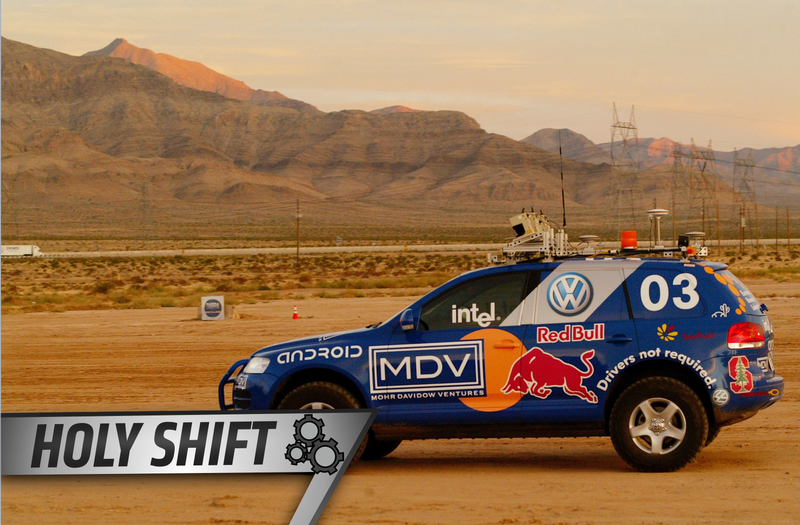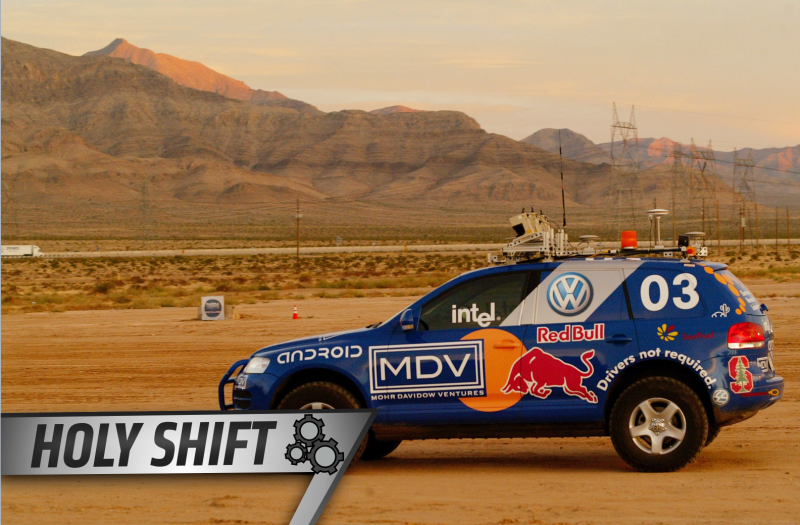
Last week, I spent a few days driving the new Mercedes-Benz E-Class. Its semi-autonomous capabilities led to some discomfort—not due to their functioning, but due to the fact that I was behind the wheel of a car driving itself. It felt odd and futuristic, but, as it turns out, this movement started way back in the 1920s.
Happy Sunday! Welcome to Holy Shift, where we highlight big innovations in the auto and racing industries each week—whether they be necessary or simply for comfort—and, on occasion, weird car history.
An early attempt at a self-driving vehicle came with the help of remote control, as the so-called “Phantom Auto” drove through the streets of Milwaukee in 1926. Another car followed the driverless vehicle, controlling it as it drove “itself” around.
Advertisement
The tone of media coverage at the time helps to show just how big of a deal that a driverless car was at the time—kind of like it still is, 90 years later. From the Milwaukee Sentinel newspaper on the day of the event, December 8, 1926:
Driverless, [the “ghost car”] will start its own motor, throw in its clutch, twist its steering wheel, toot its horn, and it may even “sass” the policeman at the corner.
The “master mind” that will guide the machine as it prowls in and out of the busy traffic will be a radio set in a car behind. Commanding waves sent from the second machine will be caught by a receiving set in the “ghost car.”
There wasn’t much documented attention surrounding self-driving vehicles for nearly two decades following the drive of the “ghost car,” and not much work went into making progress on the idea for several more. The newly emerging attempts at autonomous driving didn’t focus on the vehicles, though—a lot of them centered around an autonomous highway system.
Sponsored
The resurgence in widespread attention came at General Motors’ “Futurama” exhibit at the 1939 World’s Fair, picturing a city 20 years down the road. Per Wired, GM imagined a highway system with cars driving themselves through “abundant sunshine, fresh air [and] fine green parkways” by 1960.
GM later partnered on a scale model of a automated highway system, according to Wired. The project, finished by 1953, looked into “how electronics could be used to steer and maintain proper following distance.” According to The Atlantic, Chevrolet brought a Firebird II concept car to the stage—one that would drive with guidance from the envisioned electric highways of the future.
There were dips into autonomous public transportation in the 1960s, with ideas like the the “Self-Transit Rail and Road Car” developed by William Alden. His invention could switch from personal to public transit once it snapped its metal arms onto a railway system, per The Verge. He wasn’t the only one with the idea for a mode of transportation that could serve dual public and private purposes, but later research revealed problems in the system and essentially sunk the idea.
Other attempts came throughout the 1960s and 1970s, such as the Stanford Cart originally meant to develop lunar rovers. The cart made its way through a room filled with chairs in 1979, and, according to Wired, led the way for Stanford’s autonomous Volkswagen Touareg named “Stanley” in the early 2000s.
Advertisement
As the pattern shows, it became more about the cars—not highway systems or public transportation—as time went on.
That’s when true autonomy came along. From Wired:
What could be called the first truly autonomous car — meaning it could process images of the road ahead — was unveiled in 1977 by S. Tsugawa and his colleagues at Japan’s Tsukuba Mechanical Engineering Laboratory.As autonomous car legend Ernst Dickmanns tells it, the car was equipped with two cameras that used analog computer technology for signal processing. It was capable of speeds up to 30 km/h (18.6 mph) but was aided by an elevated rail.
An autonomous drive from Pittsburgh to Los Angeles came nearly 20 years later in 1995, featuring Carnegie Mellon University roboticists and a 1990 Pontiac Trans Sport. The car, according to Wired, scored 98.2 percent in its autonomous efforts—it needed assistance in avoiding obstacles and other areas, and the longest the car went without human intervention was 70 miles.
Then came the Grand Challenge car competitions in 2004, put on by the Defense Advanced Research Projects Agency and meant to give roboticists from different U.S. universities the chance to compete with expensive autonomous vehicles. Per The Atlantic, Google even grabbed one of the top guys from the competition to be on its autonomous efforts a few years later.
Looking at the modern state of autonomous cars, it isn’t hard to see how far the idea has come—the surprise, perhaps, stems from the knowledge that the idea has been around for as long as it has. Nowadays, we’ve got Teslas commanding themselves, weird little Google cars out driving, entire fake towns devoted to autonomous testing and self-driving “assist” systems making their way onto the consumer market.
Of course, complete autonomy is still a ways away. The systems aren’t quite perfect, and legislation—well, who knows how long that’ll take to catch up to the new rulers of the road. Autonomy is still just on the horizon, as it has been for decades.
If it’s any comfort, the human race has had 90 years to get used to this whole deal. But, I, for one, still had to bit my lip when letting a Mercedes sedan take control.
If you have suggestions for future innovations or historical notes to be featured on Holy Shift—in street cars, the racing industry or whatever you’d like—feel free to send an email to the address below or leave them in the comments section. The topic range is broad, so don’t hesitate with your ideas.













